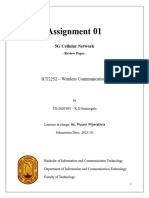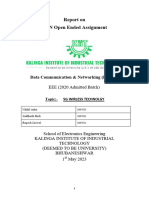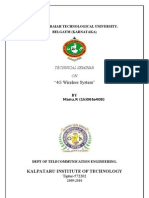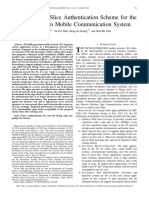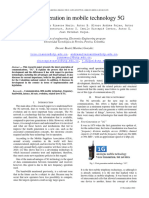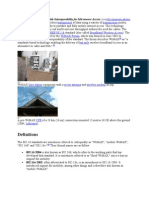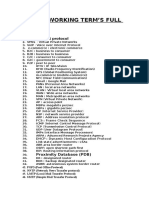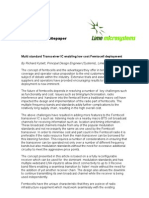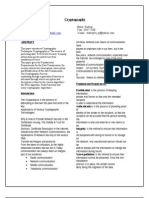Professional Documents
Culture Documents
Mathematical Interpretation of High Length Wi-Fi Network System
Mathematical Interpretation of High Length Wi-Fi Network System
Copyright
Available Formats
Share this document
Did you find this document useful?
Is this content inappropriate?
Report this DocumentCopyright:
Available Formats
Mathematical Interpretation of High Length Wi-Fi Network System
Mathematical Interpretation of High Length Wi-Fi Network System
Copyright:
Available Formats
Volume 8, Issue 12, December 2023 International Journal of Innovative Science and Research Technology
ISSN No:-2456-2165
Mathematical Interpretation of
High Length Wi-Fi Network System
*MD. Tahsin Ahmed, **Ashraful Islam, ***J. P. Clinton Corraya
Abstract:- Today's current sphere is always moving and - or generation - of wireless technology is one of the main
searching for something new. Thinking back a few forces behind the ongoing change and evolution of the telecom
millennia ago, this was only possible thanks to science. Due sector. Faster speeds, greater capacity, and new features that
to the internet, we are now able to complete tasks that improve our quality of life and connectivity come with each
were previously impossible, such as communicating with successive generation. [4] [5]
distant parties. [1] No matter where we are, we can now
see them and speak to them with relative ease. To expand II. THE 5G EFFECT ON TELECOM
the reach of communication medium, the
telecommunications industry was created. People can Broadband's current state, 5G, and its consequences.
communicate swiftly with people nearby or far away. We Budgets for telecom providers.
are able to use the internet because the The market environment and potential investment
telecommunications industry has made it possible for us to opportunities.
do so. We use this internet medium in many different ways
Faster speeds and increased capacity for activities like
as a result of science. Similar to how the router and
streaming video, downloading music, reading the web, and
broadband line (Ethernet) systems work. [1] It will be our
utilizing social media come with each successive generation.
responsibility to provide internet access to everyone in the
entire nation or world using the Wi-Fi router system. [5] And as we are all aware, nowadays, individuals use their
smartphones for purposes other than merely making phone
Because of this, anyone can access the internet whenever
calls. The telecom sector needs to invest in 5G if it wants to
they want, no matter how far they are from the network.
Network towers will be needed for our technology to remain competitive. This will not only provide them an
completely cover the nation and create Wi-Fi systems like advantage over their rivals, but it will also enable them to
the routers we see today. [1] provide the most cutting-edge technologies to their clients.5G
is significant because it has several benefits over other
Keywords:- Telecommunication Sector, Cell Tower, Internet, wireless technology generations. For starters, it boasts
Wi-Fi System. substantially faster speeds, allowing consumers to accomplish
more with their devices. Additionally, it has decreased latency,
I. INTRODUCTION which implies that using 5G-capable devices will result in less
lag. Since 5G uses less energy than earlier generations,
Today's telecommunications industry is expanding its telecom companies can reduce their energy costs. Overall, 5G
global networking efforts, and in order to do so, they are represents a significant advancement for the telecom sector. It
developing new systems. [2] like the 2G, 3G, and 4G provides greater reliability, lower latency, and higher speeds.
networks. They have recently been focusing on the 5G All of which are necessary for the upcoming creation of new
Network system. The majority of nations have access to and services and applications. [7]
are using the 5G network. For these reasons, the
telecommunicationsindustry uses a lot of towers to cover the III. DESCRIPTION OF CELL TOWER
ground and connect individuals to the network. Our primary
goal is to connect the area by building a shortage tower. [2] A. What is cell tower?
This essay demonstrates how to do so using this mathematical Cellular networks have revolutionized communication by
concept. The development of 5G wireless technology holds making wireless connectivity ubiquitous. At the very center of
the potential to transform the telecom sector and alter how we these networks are cell towers, which transmit and receive
live and work. [2] [3] This article examines how 5G will affect wireless signals as relay stations. [9] [10] Cell towers are the
the telecom sector, which will have a significant impact on linchpin of a robust wireless communication infrastructure,
almost every part of our life. The advent of 5G will alter how allowing for seamless voice and data transmissions across vast
you communicate. [3] It will have an impact on how we use geographical areas. [11]
our phones and tablets, as well as how your home
entertainment system operates. Numerous new improvements Cell towers consist of a number of crucial components
that are not conceivable without 5G will be made possible by that collectively enable wireless communication. The key
it. [4] The next generation of wireless communication, 5G, is components consist of the antenna system, transceivers,
undergoing a tremendous shift in the telecoms sector. The "G" basebandprocessing apparatus, power supply, and backhaul
connections. Transmitting and receiving radio frequency (RF)
IJISRT23DEC466 www.ijisrt.com 324
Volume 8, Issue 12, December 2023 International Journal of Innovative Science and Research Technology
ISSN No:-2456-2165
signals is the responsibility of antennas, while signal the benefits and drawbacks of using cell towers to broadcast
modulation and demodulation is handled by transceivers. Wi-Fi networks, casting light on the potential implications for
Baseband processing equipment processes signals, manages wireless connectivity. Alternative methods for delivering Wi-
network protocols, and enables mobile device connectivity. Fi networks are being investigated due to the proliferation of
Power supply system’s guarantee continuous operation, and wireless devices and the demand for ubiquitous connectivity.
backhaul connections connect the tower to the network core. [18] Utilizing existing cell tower infrastructure is a promising
[1] [11] method for extending Wi-Fi coverage and providing
dependable connectivity to a larger number of users. This
A cell tower's primary function is to provide network paper investigates the rationale behind using cell towers to
coverage and connect mobile devices to the cellular network. broadcast Wi-Fi networks, emphasizing the benefits and
The extent of a tower's coverage area, commonly referred to as drawbacks of this strategy. The Internet is a medium that
a cell or sector, can vary based on terrain, population density, allows for the dissemination of information. The entire globe
and frequency allocation. Multiple cell towers are strategically at once. The internet has brought the world into our hands
positioned to form a network of overlapping coverage areas, nowadays. We need to understand this because of the internet,
allowing users to travel between cells without interruption. which we are familiar with. Additionally, to using the many
Cell towers optimize network efficiency and assure service activities also use the internet. This website is the primary
quality by regulating signal strength, handoffs, and traffic vehicle for achieving the pinnacle of contemporary society. [2]
allocation. [13] There are a few. Today's innovations and creative ideas are
being daily growth was observed. The advent of the Internet a
There are numerous varieties of cell towers, with few years ago. We utilized it with the assistance of a wire we
macrocells, microcells, picocells, and femtocells being the named Broadband (Ethernet) line. This form of media is still
most common. Typically, towering structures with antennas, in use. However, Ethernet only allows one user to utilize a
macrocell towers provide coverage for expansive areas. device at a time. However, many individuals will be able to
Microcells, picocells, and femtocells are designed for utilize these items because router devices allow several users
localized coverage in interior environments, densely populated to use multiple devices simultaneously. [19] The main cause
areas, and specific building deployments. Population density, of development is that attempts are being made to introduce
traffic demand, network capacity, and geographical innovation as well as an increase in consumer demand brought
considerations influence the placement of towers. [15] on by the internet. There are urban and rural areas in every
The deployment and capabilities of cell towers have been nation. Both urban and rural areas exist in Bangladesh. When
significantly influenced by the development of wireless we look at our country's metropolitan areas, we see that people
technologies. The transition from 2G to 3G, 4G, and 5G have many opportunities there that rural folks do not. Rural
networks necessitated the installation of new towers and the residents are typically denied access to breakthrough
improvement of extant infrastructure. Particularly, 5G technologies. The majority of individuals in our nation use
networks rely on denser implementations of smaller cells to Ethernet, or broadband line. Some people use the prepaid and
deliver higher data rates, lower latency, and enhanced network postpaid systems that the corporation offers. However, many
capacity. [1] [2] [15] are now interested in using the internet via router systems
because they wish to utilize multiple devices or multiple
Cell towers are essential components of the wireless devices that are being used by several users at once. Figure
communication infrastructure because they allow for global illustrates how the Ethernet and router systems function. We
connectivity and meet the ever-increasing demands that are create the phone to converse with those who are far away. [2]
placed on mobile networks. [9] [17] It is vital to have an Then it was altered after the invention of the mobile phone. In
understanding of the architecture, functioning, and order for people to communicate intelligently with persons
deployment concerns of cell towerto maximize the who are far away or close by, the telecommunications industry
performance of a network, ensure that there is no disruption in must produce and provide signals. Network Tower was
connectivity, and keep up with the changing requirements of employed by the telecommunications industry to provide this
wireless communication in the digital age. signal to the user. Our system uses a controller to manage the
server, which connects directly to the Wi-Fi Network Tower
B. Why do we use cell towers to broadcast Wi-Fi? to generate the internet. [1] The main step begins once the
This research paper investigates the rationale behind internet is available for use. It connects to the tower and gives
transmitting Wi-Fi networks via cell towers. Despite the fact the user access to the internet. For security reasons, we will
that cell towers are predominantly associated with cellular provide a system for logging in. Through the login process,
communication, utilizing their infrastructure for Wi-Fi users will connect their gadgets to the internet. Data will be
deployment offers numerous advantages, including increased kept in the system and under the controller's control. The
coverage, reduced costs, and simplified network management. majority of network tower types were employed in the
[18] However, this strategy also presents interference, telecommunications industry. [1]
scalability, and compatibility issues. This paper investigates
IJISRT23DEC466 www.ijisrt.com 325
Volume 8, Issue 12, December 2023 International Journal of Innovative Science and Research Technology
ISSN No:-2456-2165
Rooftop refers to a network tower that is installed on a is also employed here. [2] The network tower developed and
roof, whereas green field refers to a network tower that is offers the user this technique. Although not an easy process, it
installed in an open space. The internet is currently used by is a useful system for improved communication. They used it
the telecommunications industry. [1] They are utilizing the to connect users to the internet. The telecommunications
network towers for this. The work of internet service provider industry also considers those individuals who cannot find a
networks and mobile network towers is slightly different, but Wi-Fi infrastructure to connect their devices, therefore they
it is consistent with the work process. Recently, the 2G and 3G purchase data packages. Users purchase data to utilize the
systems have been developed in our nation's telecom sector. internet, and they can do it with ease. Though it was first
They employed this for long-distance coverage. Systems, both designed for residents of rural areas, the system is currently
2G and 3G. For, this system is very beneficial improved used by all users. [1]
communication. The 2G system has a long range. [1] Through
this method, calling other live individuals is simple. In a far IV. UTILIZING CELL TOWERS FOR WI-FI
location from them. Wireless is the name of this procedure. BROADCASTING OFFERS THESE BENEFITS
Process of voice communication. Use of the 3G system
UMTS. EDGE and UMT (Universal Mobile Telecom Extended Coverage: Cell towers are strategically placed to
System). As a result, video call procedure, we can. provide coverage over a wide area for cellular
Additionally, HSDPA (High Speed both HSUPA (High Speed communications. Utilizing these towers for Wi-Fi
Uplink Packet) and DL Packed Access and HSUPA (High broadcasting expands coverage to areas where traditional
Speed Uplink Packet Access). This method makes Wi-Fi access points may not be practicable or affordable.
downloading simple. The LTE (Long Term Evolution) system [2] [3]
Table 1: Structure of Tower
Name Height
Green Field 34m + Outdoor
Roof Top 32m + Outdoor
Roof Top/Green Field 29m/32m + Outdoor
Infrastructure Reuse: Utilizing existing cell tower Compatibility and Standards: For seamless integration
infrastructure reduces the need for additional infrastructure and interoperability, it is essential to ensure compatibility
deployment, resulting in cost savings and faster network between cellular and Wi-Fi technologies, such as by
deployment. [1] addressing differences in frequency bands and network
Simplified Network Management: Cell towers are protocols. [6]
already equipped with robust administration and Infrastructure Limitations: For efficient Wi-Fi
monitoring systems, allowing for simplified network broadcasting, the power supply, backhaul capacity, and
management. Integrating Wi-Fi broadcasting into the antenna configurations of the existing cell tower
existing tower infrastructure simplifies network infrastructure may need to be addressed. [15]
administration and maintenance of separate systems. [21]
Seamless Handovers: By leveraging cell tower Utilizing cell towers for broadcasting Wi-Fi networks
infrastructure, Wi-Fi networks can seamlessly transfer offers various advantages, including extended coverage, cost
connections between cellular and Wi-Fi networks, savings, improved network management, and seamless
providing mobile devices with uninterrupted connectivity. handovers. However, difficulties relating to interference,
[22] scalability, compatibility, and infrastructure restrictions must
be carefully addressed to ensure optimal performance and a
V. DIFFICULTIES AND CONSIDERATIONS seamless user experience. By identifying and overcoming
these problems, using cell towers for Wi-Fi broadcasting can
Interference: Coexistence challenges may arise when play a crucial role in expanding wireless access and fulfilling
operating Wi-Fi networks and cellular networks on the the growing demands of digital communication. [18]
same tower, potentially resulting in interference issues that
can affect network performance. [3] VI. OPTIMIZING CELL TOWER SETUP FOR
OPTIMAL WI-FI COVERAGE: STRATEGIES
As the number of connected devices grows, the AND CONSIDERATIONS
scalability of Wi-Fi networks deployed on cell towers ACKNOWLEDGEMENTS
becomes a crucial factor. For optimal performance, the
tower's capacity and the number of simultaneous Establishing a cell tower to disseminate Wi-Fi networks
connections must be carefully managed. [5] necessitates the strategic configuration of multiple elements to
ensure optimal coverage. This paper explores the essential
considerations and strategies for installing a cell tower to
IJISRT23DEC466 www.ijisrt.com 326
Volume 8, Issue 12, December 2023 International Journal of Innovative Science and Research Technology
ISSN No:-2456-2165
maximize Wi-Fi coverage, including placement, antenna IX. FORMULA
selection, transmission power management, and interference
mitigation strategies. To estimate the coverage area of a cell tower, we can use
the following formula:
VII. METHODS FOR OPTIMAL CELL TOWER
INSTALLATION Coverage Area = π × (Distance)^2
It is essential to identify the optimal location for the cell Where π is the mathematical constant pi (approximately
tower. Population density, geographic terrain, and building 3.14), and distance is the maximum distance from the tower at
structures must be taken into account to ensure broad coverage which the signal strength is still sufficient for reliable
and minimize obstacles that may impede signal propagation. communication. Let's assume that a cell tower has a transmit
power of 40 watts and is equipped with a directional antenna
Choice of Antenna: Choosing the proper form of antenna with a gain of 18 dBi (decibels relative to isotropic). The
is crucial for attaining the desired coverage pattern. Omni- tower is also located on a high point, such as a hill or a tall
directional antennas radiate signals in all directions, building, giving it an effective height of 50 meters above
whereas directional antennas direct the signal in a specific ground level. Using a radio propagation model, we can
direction. The selection depends on variables such as estimate that the maximum distance from the tower at which
coverage area, desired range, and potential sources of the signal strength is still sufficient for reliable communication
interference. [1] is approximately 15 kilometers. Plugging this value into the
Transmission Power Management: To achieve a balance formula above, we get:
between coverage and interference, it is essential to adjust
the transmission power of the cell tower. Optimizing Coverage Area = 3.14 × (15 km) ^2 = 706.5 square
power levels helps prevent unnecessary signal overspill kilometers
and reduces the likelihood of interfering with adjacent
networks. Also, to offer seamless coverage over greater areas,
Interference Mitigation: Interference from other Wi-Fi wireless operators frequently employ a network of connected
networks, electrical devices, or physical structures can cell towers. This is referred to as a cellular network, and it
reduce network coverage. Techniques such as channel enables wireless devices to change towers as they move from
selection, frequency planning, and interference-avoidance one place to another while keeping an ongoing internet
mechanisms such as beamforming can be used to reduce connection.
interference and improve Wi-Fi coverage.
X. CONCLUSION
To achieve optimal coverage when transmitting Wi-Fi We have mostly focused on our papers, which provide
networks through a cell tower, [1] meticulous planning and internet access throughout the world via Wi-Fi network tower
implementation are required. Crucial aspects of the setup systems, and we have created limitation network towers for
procedure include optimizing tower positioning, selecting the region to provide indemnity. Our primary focal split is
suitable antennas, managing transmission power, and this. We divided the work in order to achieve our job goal and
mitigating interference. By employing effective strategies and complete our mission. We started by tackling the limitation
taking into account these key factors, operators can construct area. Following that, we worked on city before moving on to
cell towers that provide optimal Wi-Fi coverage, thereby diverge. However, our mission or objective is to expand the
meeting the wireless connectivity demands of the present day. user base while providing internet to all nations. Additionally,
VIII. METHODS FOR OPTIMAL CELL TOWER we discussed network tower fetch and the Wi-Fi network
INSTALLATION tower system to determine which tower is most effective at
providing internet access. Because the internet and people are
Typically, a few kilometers around the tower, a cell both essential to our world, if this system succeeds,
tower can help provide wireless internet service within a employment growth will also increase. Each job requires
constrained geographic area. Many cell towers would need to access to the internet. People will always use the internet if it
be strategically placed to cover as much ground as possible in is created. For this reason, we also want strong power plants
order to offer service for a full nation. The height of the tower, that continuously supply electricity. This approach is quite
the frequency of the signal, the transmit strength of the effective for better communication and professional
antenna, the topography, and nearby obstructions are just a development, although more research is needed on this topic.
few of the variables that affect a cell tower's coverage area. As [1]
a result, a single cell tower may effectively cover an area of
about 700 square kilometers. Many cell towers would need to
be strategically placed to cover as much ground as possible in
order to offer service for a full nation.
IJISRT23DEC466 www.ijisrt.com 327
Volume 8, Issue 12, December 2023 International Journal of Innovative Science and Research Technology
ISSN No:-2456-2165
REFERENCES [21]. Spirent Communications. http://www.spirentcom.com.
[22]. L. Subramanian, I. Stoica, H. Balakrishnan, and R. Katz.
[1]. D. Aguayo, J. Bicket, S. Biswas, G. Judd, and R. Morris. OverQoS: An Overlay Based Architecture for Enhancing
Link-level Measurements from an 802.11b Mesh Internet QoS. In USENIX/ACM NSDI, March 2004.
Network. In ACM SIGCOMM, Aug. 2004. [23]. L. Subramanian, S. Surana, R. Patra, M. Ho, A. Sheth,
[2]. H. Balakrishan. Challenges to Reliable Data Transport and E. Brewer. Rethinking Wireless for the Developing
over Heterogeneous Wireless Networks. PhD thesis, World. Hotnets-V, 2006.
University of California at Berkeley, Aug. 1998. [24]. The Akshaya E-Literacy Project.
[3]. H. Balakrishnan, S. Seshan, E. Amir, and R. Katz. http://www.akshaya.net.
Improving TCP/IP Performance over Wireless Networks. [25]. WiMAX forum. http://www.wimaxforum.org.
In ACM MOBICOM, Nov. 1995.
[4]. P. Bhagwat, B. Raman, and D. Sanghi. Turning 802.11
Inside-out. ACM SIGCOMM CCR, 2004.
[5]. S. Biswas and R. Morris. Opportunistic Routing in
Multi-Hop Wireless Networks. Hotnets-II, November
2003.
[6]. E. Brewer. Technology Insights for Rural Connectivity.
Oct. 2005.
[7]. K. Chebrolu, B. Raman, and S. Sen. Long-Distance
802.11b Links: Performance Measurements and
Experience. In ACM MOBICOM, 2006.
[8]. Connecting Rural Communities with WiFi.
http://www.crc.net.nz.
[9]. Digital Gangetic Plains. http://www.iitk.ac.in/mladgp/.
[10]. C. Doerr, M. Neufeld, J. Filfield, T. Weingart, D. C.
Sicker, and D. Grunwald. MultiMAC - An Adaptive
MAC Framework for Dynamic Radio Networking. In
IEEE DySPAN, Nov. 2005.
[11]. E. Kohler, R. Morris, B. Chen, J. Jannotti, and M. F.
Kaashoek. The Click Modular Router. ACM
Transactions on Computer Systems, 18(3):263-297, Aug.
2000.
[12]. S. Lin and D. Costello. Error Control Coding:
Fundamentals and Applications. Prentice Hall, 1983.
[13]. D. L. Mills. Internet Time Synchronization: The Network
Time Protocol. In Global States and Time in Distributed
Systems, IEEE Computer Society Press. 1994.
[14]. M. Neufeld, J. Fifield, C. Doerr, A. Sheth, and D.
Grunwald. SoftMAC – Flexible Wireless Research
Platform. In HotNets-IV, Nov. 2005.
[15]. Partnership for Higher Education in Africa. Securing the
Linchpin: More Bandwidth at Lower Cost, 2006.
[16]. B. Raman and K. Chebrolu. Revisiting MAC Design for
an 802.11-based Mesh Network. In HotNets-III, 2004.
[17]. B. Raman and K. Chebrolu. Design and Evaluation of a
new MAC Protocol for Long-Distance 802.11 Mesh
Networks. In ACM MOBICOM, Aug. 2005.
[18]. A. Rao and I. Stoica. An Overlay MAC layer for 802.11
Networks. In MOBISYS, Seattle,WA, USA, June 2005.
[19]. L. Rizzo. Effective Erasure codes for Reliable Computer
Communication Protocols. ACM CCR, 1997.
[20]. A. Sheth, S. Nedevschi, R. Patra, S. Surana, L.
Subramanian, and E. Brewer. Packet Loss
Characterization in WiFi-based Long Distance Networks.
IEEE INFOCOM, 2007.
IJISRT23DEC466 www.ijisrt.com 328
You might also like
- 5g Document MergedDocument24 pages5g Document Mergedwasim.No ratings yet
- CT-539 Advance Computer Networking Report On,: 5G Wireless System'Document11 pagesCT-539 Advance Computer Networking Report On,: 5G Wireless System'Khawaja RameezNo ratings yet
- AS400 MultiprotocolDocument582 pagesAS400 MultiprotocolDos Cuarentaydos Desde MéxicoNo ratings yet
- Comparative Study On Wireless Mobile Technology 1G, 2G, 3G, 4G and 5GDocument5 pagesComparative Study On Wireless Mobile Technology 1G, 2G, 3G, 4G and 5GnhatvpNo ratings yet
- Preparation of Your Project Report (5G Standards)Document6 pagesPreparation of Your Project Report (5G Standards)AneelaMalikNo ratings yet
- Train Control SystemDocument122 pagesTrain Control SystemLanggeng NFR'BNo ratings yet
- A Survey of 5G Network: Architecture and Emerging TechnologiesDocument27 pagesA Survey of 5G Network: Architecture and Emerging TechnologiesDijar VrellaNo ratings yet
- Project On Wireless System: Presented byDocument22 pagesProject On Wireless System: Presented byConnect Net cafeNo ratings yet
- 6352 DS PDFDocument2 pages6352 DS PDFLafi FahedNo ratings yet
- 5G DocumentationDocument12 pages5G DocumentationNathan BilungaNo ratings yet
- A Literature Review of Security in 5G.Document9 pagesA Literature Review of Security in 5G.Merisha Subedi100% (1)
- 5G Heterogenous NetworkDocument9 pages5G Heterogenous NetworkBhumika PiplaniNo ratings yet
- (IJETA-V8I4P1) : Vijay Kumar, Sonam GourDocument6 pages(IJETA-V8I4P1) : Vijay Kumar, Sonam GourIJETA - EighthSenseGroupNo ratings yet
- An Overview of 5G Requirements and Future Wireless NetworksDocument7 pagesAn Overview of 5G Requirements and Future Wireless Networkslakshmivs23No ratings yet
- Towards The 5th Generation of Wireless Communication SystemsDocument15 pagesTowards The 5th Generation of Wireless Communication SystemsrajibuleceNo ratings yet
- Assignment 01: 5G Cellular NetworkDocument21 pagesAssignment 01: 5G Cellular NetworkKavindu DilharaNo ratings yet
- Report_Cellular 3G,4G,5G_update2Document7 pagesReport_Cellular 3G,4G,5G_update2abdalla.ahmet60No ratings yet
- Future Outlook and RecommendationsDocument4 pagesFuture Outlook and RecommendationsAminul IslamNo ratings yet
- 5G Rural Low Income ZonesDocument9 pages5G Rural Low Income ZonesEdwinNo ratings yet
- 5G Wireless Technology ReportDocument3 pages5G Wireless Technology ReportParasiteNo ratings yet
- A Literature Survey On Applications of 5G Technologies For Water Resource ManagementDocument8 pagesA Literature Survey On Applications of 5G Technologies For Water Resource ManagementIJRASETPublicationsNo ratings yet
- "4G Wireless System": Technical Seminar ONDocument19 pages"4G Wireless System": Technical Seminar ONVenkatesh PurumalaNo ratings yet
- 5G Original FileDocument7 pages5G Original FileAtta Ullah AfridiNo ratings yet
- Introduction Technical Sem Srinidhi inDocument9 pagesIntroduction Technical Sem Srinidhi inSahana GNo ratings yet
- 5G Mini Project PresentationDocument30 pages5G Mini Project PresentationNew worldNo ratings yet
- 5G Simple ExplanationDocument11 pages5G Simple ExplanationSertse Dingle ShewandagnNo ratings yet
- A Survey of 5G Network Architecture and Emerging TechnologiesDocument27 pagesA Survey of 5G Network Architecture and Emerging TechnologiesJharakesh NetwoksNo ratings yet
- Y.B. Patil Polytechnic, Akurdi, Pune: Academic Year:-2022-23Document20 pagesY.B. Patil Polytechnic, Akurdi, Pune: Academic Year:-2022-23Divya PatilNo ratings yet
- The Potential Short-And Long-Term Disruptions and Transformative Impacts of 5G and Beyond Wireless Networks: Lessons Learnt From The Development of A 5G Testbed EnvironmentDocument28 pagesThe Potential Short-And Long-Term Disruptions and Transformative Impacts of 5G and Beyond Wireless Networks: Lessons Learnt From The Development of A 5G Testbed EnvironmentMarcus LimNo ratings yet
- Cross-Network-Slice Authentication Scheme For The 5th Generation Mobile Communication SystemDocument12 pagesCross-Network-Slice Authentication Scheme For The 5th Generation Mobile Communication SystemSimran khan SimNo ratings yet
- 5G Technology and Wireless NetworkDocument4 pages5G Technology and Wireless NetworkFarwa NaqviNo ratings yet
- 5G Network (Prospects and Applications)Document8 pages5G Network (Prospects and Applications)Eriharemien Emmanuel OsaregueNo ratings yet
- Roll No 36 Shivani Pandey 5G NetworkDocument5 pagesRoll No 36 Shivani Pandey 5G Networktapasya2097No ratings yet
- Fifth Generation Seminar ReportDocument25 pagesFifth Generation Seminar ReportNkanu OkpaNo ratings yet
- Ref 17-Des Of5g PDFDocument5 pagesRef 17-Des Of5g PDFsssNo ratings yet
- 5G Wireless Technology: A Primer: July 2018Document4 pages5G Wireless Technology: A Primer: July 2018rehan zeb khanNo ratings yet
- Sample Format12 PDFDocument22 pagesSample Format12 PDFNnnNo ratings yet
- Reducing Latency in 5G NetworksDocument5 pagesReducing Latency in 5G NetworksInternational Journal of Innovative Science and Research TechnologyNo ratings yet
- Security Enhancement in MANET With 4GDocument4 pagesSecurity Enhancement in MANET With 4GSilverline HartNo ratings yet
- Overview of Millimeter Wave Communications For Fifth-Generation (5G) Wireless Networks-With A Focus On Propagation ModelsDocument15 pagesOverview of Millimeter Wave Communications For Fifth-Generation (5G) Wireless Networks-With A Focus On Propagation ModelsBob builderNo ratings yet
- 5G Roadmap - 10 Key Enabling TechnologiesDocument44 pages5G Roadmap - 10 Key Enabling TechnologiesDjiems GauthierNo ratings yet
- 5G Wireless Technology: A Primer: July 2018Document4 pages5G Wireless Technology: A Primer: July 2018Toma Kazashim PreciousNo ratings yet
- 4G Wireless TechnologyDocument3 pages4G Wireless TechnologyEditor IJTSRDNo ratings yet
- 5G MOBILE TECHNOLOGYDocument8 pages5G MOBILE TECHNOLOGYbirukdrummerNo ratings yet
- Study of Challenges in Migration To 5G NetworkDocument23 pagesStudy of Challenges in Migration To 5G NetworkBezawit MekonnenNo ratings yet
- IEEEconferenceEzhilDocument6 pagesIEEEconferenceEzhilChahinez HARZALLAHNo ratings yet
- Issues and Challenges in 5G Mobile NetworkDocument7 pagesIssues and Challenges in 5G Mobile NetworkIJRASETPublicationsNo ratings yet
- Design of Mobile Communication Mimo System With OfdmDocument5 pagesDesign of Mobile Communication Mimo System With OfdmInternational Journal of Innovations in Engineering and Technology (IJIET)No ratings yet
- Latest Generation Movile 5G Group 1Document6 pagesLatest Generation Movile 5G Group 1juanseco1910No ratings yet
- bhandari2018Document6 pagesbhandari2018م/محمد عبده علي احمدNo ratings yet
- Research Paper 5GDocument7 pagesResearch Paper 5GMubashir HussainNo ratings yet
- Zhang 2009Document4 pagesZhang 2009gundalabajahitamNo ratings yet
- 656f688170d677001e764170-solidDocument4 pages656f688170d677001e764170-solidArun KumarNo ratings yet
- ProQuestDocuments 2024 03 26Document4 pagesProQuestDocuments 2024 03 26Naveen BhajantriNo ratings yet
- 5 GDocument25 pages5 GNithin Si100% (3)
- Vinayak Pujari Research Paper On Future of 5G Wireless SystemDocument6 pagesVinayak Pujari Research Paper On Future of 5G Wireless Systemjessy jamesNo ratings yet
- WimaxDocument16 pagesWimaxMohammed Fazle Sobhan ChowdhuryNo ratings yet
- 5G pptDocument10 pages5G pptsayyedzuber5anasNo ratings yet
- Advancing_5G_Connectivity_A_Comprehensive_Review_oDocument19 pagesAdvancing_5G_Connectivity_A_Comprehensive_Review_osajidNo ratings yet
- Cloud Technologies For Flexible 5G Radio Access NetworksDocument12 pagesCloud Technologies For Flexible 5G Radio Access Networksmalli gaduNo ratings yet
- 5G Mobile Technology: Abstract-Existing Research Work in Mobile Communication Is Related To 5G Technology. in 5GDocument5 pages5G Mobile Technology: Abstract-Existing Research Work in Mobile Communication Is Related To 5G Technology. in 5GA RNo ratings yet
- The 5G Revolution: How the Next Generation of Wireless Will Change EverythingFrom EverandThe 5G Revolution: How the Next Generation of Wireless Will Change EverythingNo ratings yet
- Solar Based Multilevel Inverter f o r BLDC Motor DriveDocument8 pagesSolar Based Multilevel Inverter f o r BLDC Motor DriveInternational Journal of Innovative Science and Research TechnologyNo ratings yet
- Unlocking Sentiments: Enhancing IOCL Petrol Pump ExperiencesDocument8 pagesUnlocking Sentiments: Enhancing IOCL Petrol Pump ExperiencesInternational Journal of Innovative Science and Research TechnologyNo ratings yet
- Exploring the Potential Advantages of Traditional Therapies in Autoimmune Blistering Illnesses: A Comprehensive Review and Analysis, ResearchDocument12 pagesExploring the Potential Advantages of Traditional Therapies in Autoimmune Blistering Illnesses: A Comprehensive Review and Analysis, ResearchInternational Journal of Innovative Science and Research TechnologyNo ratings yet
- Smart and Secure Home with ChatbotDocument9 pagesSmart and Secure Home with ChatbotInternational Journal of Innovative Science and Research TechnologyNo ratings yet
- Meta Land: Redefining Virtual Communities through Centralized Governance, Inclusivity and InnovationDocument5 pagesMeta Land: Redefining Virtual Communities through Centralized Governance, Inclusivity and InnovationInternational Journal of Innovative Science and Research TechnologyNo ratings yet
- Seasonal Variation and Distribution Patterns of Endophytic Community in Withania somniferaDocument7 pagesSeasonal Variation and Distribution Patterns of Endophytic Community in Withania somniferaInternational Journal of Innovative Science and Research TechnologyNo ratings yet
- Skin Disease Detection and Remedial SystemDocument7 pagesSkin Disease Detection and Remedial SystemInternational Journal of Innovative Science and Research TechnologyNo ratings yet
- Design and Development of Multi-Featured Medical StretcherDocument4 pagesDesign and Development of Multi-Featured Medical StretcherInternational Journal of Innovative Science and Research TechnologyNo ratings yet
- Global Warming Reduction Proposal AssessmentDocument6 pagesGlobal Warming Reduction Proposal AssessmentInternational Journal of Innovative Science and Research TechnologyNo ratings yet
- Development of Smart Ground Fault Location Model for Radial Distribution SystemDocument14 pagesDevelopment of Smart Ground Fault Location Model for Radial Distribution SystemInternational Journal of Innovative Science and Research TechnologyNo ratings yet
- EmoConnect: Nurturing Trust and Relationship Bonds in Alzheimer’s ConversationsDocument3 pagesEmoConnect: Nurturing Trust and Relationship Bonds in Alzheimer’s ConversationsInternational Journal of Innovative Science and Research TechnologyNo ratings yet
- Preparation and Identification of Magnetic Iron Nanoparticle based on a Natural Hydrogel and its Performance in Targeted Drug DeliveryDocument17 pagesPreparation and Identification of Magnetic Iron Nanoparticle based on a Natural Hydrogel and its Performance in Targeted Drug DeliveryInternational Journal of Innovative Science and Research TechnologyNo ratings yet
- Firm Size as a Mediator between Inventory Management Andperformance of Nigerian CompaniesDocument8 pagesFirm Size as a Mediator between Inventory Management Andperformance of Nigerian CompaniesInternational Journal of Innovative Science and Research TechnologyNo ratings yet
- Application of Plant Growth Promoting Rhizobacteria on Vegetative Growth in Chili Plants (Capsicum frutescens L.)Document7 pagesApplication of Plant Growth Promoting Rhizobacteria on Vegetative Growth in Chili Plants (Capsicum frutescens L.)International Journal of Innovative Science and Research TechnologyNo ratings yet
- Reading Intervention Through “Brigada Sa Pagbasa”: Viewpoint of Primary Grade TeachersDocument3 pagesReading Intervention Through “Brigada Sa Pagbasa”: Viewpoint of Primary Grade TeachersInternational Journal of Innovative Science and Research TechnologyNo ratings yet
- On the Development of a Threat Driven Model for Campus NetworkDocument14 pagesOn the Development of a Threat Driven Model for Campus NetworkInternational Journal of Innovative Science and Research TechnologyNo ratings yet
- PHREEQ C Modelling Tool Application to Determine the Effect of Anions on Speciation of Selected Metals in Water Systems within Kajiado North Constituency in KenyaDocument71 pagesPHREEQ C Modelling Tool Application to Determine the Effect of Anions on Speciation of Selected Metals in Water Systems within Kajiado North Constituency in KenyaInternational Journal of Innovative Science and Research TechnologyNo ratings yet
- Exploring the Post-Annealing Influence on Stannous Oxide Thin Films via Chemical Bath Deposition Technique: Unveiling Structural, Optical, and Electrical DynamicsDocument7 pagesExploring the Post-Annealing Influence on Stannous Oxide Thin Films via Chemical Bath Deposition Technique: Unveiling Structural, Optical, and Electrical DynamicsInternational Journal of Innovative Science and Research TechnologyNo ratings yet
- Osho Dynamic Meditation; Improved Stress Reduction in Farmer Determine by using Serum Cortisol and EEG (A Qualitative Study Review)Document8 pagesOsho Dynamic Meditation; Improved Stress Reduction in Farmer Determine by using Serum Cortisol and EEG (A Qualitative Study Review)International Journal of Innovative Science and Research TechnologyNo ratings yet
- A Study to Assess the Knowledge Regarding Teratogens Among the Husbands of Antenatal Mother Visiting Obstetrics and Gynecology OPD of Sharda Hospital, Greater Noida, UpDocument5 pagesA Study to Assess the Knowledge Regarding Teratogens Among the Husbands of Antenatal Mother Visiting Obstetrics and Gynecology OPD of Sharda Hospital, Greater Noida, UpInternational Journal of Innovative Science and Research TechnologyNo ratings yet
- Application of Game Theory in Solving Urban Water Challenges in Ibadan-North Local Government Area, Oyo State, NigeriaDocument9 pagesApplication of Game Theory in Solving Urban Water Challenges in Ibadan-North Local Government Area, Oyo State, NigeriaInternational Journal of Innovative Science and Research TechnologyNo ratings yet
- Mandibular Mass Revealing Vesicular Thyroid Carcinoma A Case ReportDocument5 pagesMandibular Mass Revealing Vesicular Thyroid Carcinoma A Case ReportInternational Journal of Innovative Science and Research TechnologyNo ratings yet
- Esophageal Melanoma - A Rare NeoplasmDocument3 pagesEsophageal Melanoma - A Rare NeoplasmInternational Journal of Innovative Science and Research TechnologyNo ratings yet
- Detection of Phishing WebsitesDocument6 pagesDetection of Phishing WebsitesInternational Journal of Innovative Science and Research TechnologyNo ratings yet
- Consistent Robust Analytical Approach for Outlier Detection in Multivariate Data using Isolation Forest and Local Outlier FactorDocument5 pagesConsistent Robust Analytical Approach for Outlier Detection in Multivariate Data using Isolation Forest and Local Outlier FactorInternational Journal of Innovative Science and Research TechnologyNo ratings yet
- The Impact of Music on Orchid plants Growth in Polyhouse EnvironmentsDocument5 pagesThe Impact of Music on Orchid plants Growth in Polyhouse EnvironmentsInternational Journal of Innovative Science and Research Technology100% (1)
- Vertical Farming System Based on IoTDocument6 pagesVertical Farming System Based on IoTInternational Journal of Innovative Science and Research TechnologyNo ratings yet
- Sustainable Energy Consumption Analysis through Data Driven InsightsDocument16 pagesSustainable Energy Consumption Analysis through Data Driven InsightsInternational Journal of Innovative Science and Research TechnologyNo ratings yet
- Realigning Curriculum to Simplify the Challenges of Multi-Graded Teaching in Government Schools of KarnatakaDocument5 pagesRealigning Curriculum to Simplify the Challenges of Multi-Graded Teaching in Government Schools of KarnatakaInternational Journal of Innovative Science and Research TechnologyNo ratings yet
- Investigating Non-Newtonian Fluid Behavior in Hydrocyclones Via Computational Fluid DynamicsDocument18 pagesInvestigating Non-Newtonian Fluid Behavior in Hydrocyclones Via Computational Fluid DynamicsInternational Journal of Innovative Science and Research TechnologyNo ratings yet
- Alcatel Lucent WIMAXDocument124 pagesAlcatel Lucent WIMAXAlejandroNo ratings yet
- Chung Sung Han 200910 PHDDocument194 pagesChung Sung Han 200910 PHDTomer YoselevichNo ratings yet
- Odi-065r15mjjjj-G DS 200 PDFDocument4 pagesOdi-065r15mjjjj-G DS 200 PDFСергей МирошниченкоNo ratings yet
- SN75176 RS-485 CommunicationDocument7 pagesSN75176 RS-485 Communicationmarquitos550bNo ratings yet
- PTCL ReportDocument83 pagesPTCL ReportShah ZaibNo ratings yet
- Chapter 4 Communication and Network Security (Domain 4) - CISSP Official (ISC) 2 Practice TestsDocument15 pagesChapter 4 Communication and Network Security (Domain 4) - CISSP Official (ISC) 2 Practice TestsVeli AnlamaNo ratings yet
- Full Form of Networking TermsDocument2 pagesFull Form of Networking TermsPrem Abish Pokhrel75% (4)
- 4.-Hp h3c Irf SettingDocument9 pages4.-Hp h3c Irf SettingLuis G. AlarconNo ratings yet
- Massive OID ListDocument6 pagesMassive OID ListCarlosNo ratings yet
- LimeMicro Whitepaper2 PDFDocument7 pagesLimeMicro Whitepaper2 PDFThevesteNo ratings yet
- Minimono: User ManualDocument49 pagesMinimono: User ManualLBDAengineNo ratings yet
- V16.0 BSS (Access) Parameters User Guide - bPUG: External DocumentDocument534 pagesV16.0 BSS (Access) Parameters User Guide - bPUG: External DocumentvramakrishnabsnlNo ratings yet
- Hoja de Datos de ETX-1Document4 pagesHoja de Datos de ETX-1Jose Danilo Caldera SaballosNo ratings yet
- Lec34 210102090 Susanna JosephDocument5 pagesLec34 210102090 Susanna Josephvasu sainNo ratings yet
- 742352V01Document2 pages742352V01Alif WijatmokoNo ratings yet
- MicrowavesDocument17 pagesMicrowavesJannie JungcoNo ratings yet
- Cryptography Full ReportDocument9 pagesCryptography Full ReportSushant SharmaNo ratings yet
- 507 PDFDocument112 pages507 PDFgkk001No ratings yet
- Chapter 5 - Wireless WANDocument57 pagesChapter 5 - Wireless WANalomarianas52No ratings yet
- Tutorial On Technical Challenges Associated With The Evolution To VoipDocument34 pagesTutorial On Technical Challenges Associated With The Evolution To VoipsiswisnuNo ratings yet
- NLB Core Technology OverviewDocument56 pagesNLB Core Technology Overviewsanjeev_prasadNo ratings yet
- Lista Canale OROC TV Prin Cablu 24 Iunie 2022Document5 pagesLista Canale OROC TV Prin Cablu 24 Iunie 2022kukori143No ratings yet
- Introduction To IPTV, Technology, Standards & SystemsDocument36 pagesIntroduction To IPTV, Technology, Standards & SystemsCong-Son TranNo ratings yet
- Daily Reports Postilion: Alarms - A05W063Document8 pagesDaily Reports Postilion: Alarms - A05W063dbvruthwizNo ratings yet
- Introduction To Computer NetworkingDocument28 pagesIntroduction To Computer NetworkingKendrewNo ratings yet
- ASMI 51 ManualDocument115 pagesASMI 51 ManuallilunguNo ratings yet















